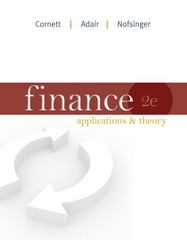Question
This question contains three parts. Please show your numeric answers as percentages with two decimal places (XX.XX%). a) Assume that at the end of 2008,
This question contains three parts. Please show your numeric answers as percentages with two decimal places (XX.XX%).
a) Assume that at the end of 2008, the level of S&P 500 index was 980, the expected annual dividend yield on the index in 2009 was 2.1%, and the expected annual growth rate in dividends in the long term was 7.5%. The long-term U.S. government yearly bond yield at the end of 2008 was 1.9%. What was the implied annual market risk premium for the U.S. stock market at the end of 2008?
b) Assume that the total returns from holding an equity portfolio were 25%, 28% and -30% in 2017, 2018 and 2019 respectively. What was the arithmetic average annual return during this three-year period? What was the geometric average annual return during this three-year period? Which average return is more suitable for making forecast of future return for this equity portfolio? Please briefly explain your choice.
c) At the end of 2019, you were a financial manager managing a growth equity portfolio for a mutual fund in New Zealand. You were valuing a stock to be added to your portfolio. You had the cash flow projection ready and had to choose a market risk premium as the input into the CAPM to estimate the cost of equity for this stock. Assume that, at the end of 2019, the implied annual market risk premium in New Zealand was 5.50% and the 90-year historical average annual market risk premium in New Zealand was 7.50%. Which market risk premium is more appropriate for this valuation exercise? Please briefly explain your choice and comment on the likely impact on valuation if you applied the unsuitable market risk premium.
Step by Step Solution
There are 3 Steps involved in it
Step: 1

Get Instant Access to Expert-Tailored Solutions
See step-by-step solutions with expert insights and AI powered tools for academic success
Step: 2

Step: 3

Ace Your Homework with AI
Get the answers you need in no time with our AI-driven, step-by-step assistance
Get Started


